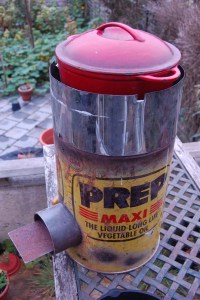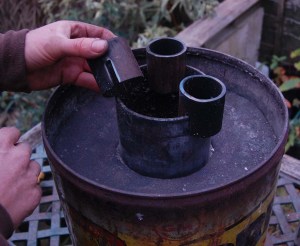Oh the joy of cooking outdoors. Possibly it is only surpassed by the subsequent joy of devouring outdoors the scrummy things that you cooked! Now I like a good campfire as much as the next kippered outdoorswoman, but when camping in the woods for up to a month at a time, cooking every meal, everyday over a fire makes smoke inhalation quite speedily loose its charm. With all the free fuel available, literally dropping from the sky, who is going to spend folding cash on camping gas? Enter the rocket stove, bosom buddy of woodland life.
We made our first rocket stove about 10 years ago and used if intermittently until the flue burned through and a sizeable quantity of the insulation escaped. It then went into extended hibernation (also known as ‘storage’) but was refurbished and brought back into service about 2 years ago. Thank HEAVENS! Now we have it in use again, I can’t believe we camped without it for so long.
It is completely smokeless once up and going and is extremely efficient, boiling water quickly and with very little fuel. It can be set on a tree stump or table so there is no stooping to tend fire or food. It has totally transformed our experience of cooking in the woods, and is the perfect partner to our lovely haybox – of which more in the next blog. In case you are considering making one, which we highly recommend, there is only one limiting factor that we have found to cooking on them: a rocket stove has a VERY tiny burn chamber. This is one of the strengths of the design, making best use of small amounts of kindling-type fuel. However, it does mean that you must keep feeding the fire as there is not much in the way of embers to keep the fire going if you turn your back for long. In all other regards the rocket stove is king.
Our original stove was made according to a common quick and easy design. A large cooking oil tin and a section of 4” cheap ducting pipe form the main components. This flue has had to be replaced twice in the time we’ve used it as it burns through quite quickly. This time, its third incarnation, I have replaced the ducting with 2mm thick, 4.5” diameter steel tube, welded into an L bend. The usual cheap and cheerful design of rocket stove uses the top rim of the wind-shield to support the handles of the cooking pot, the belly of which dangles over the flame. In our upgrade the weight of the pot is now supported directly by the flue. Three chopped bits of scaffolding tube which slot onto the flue create space for the rising flame and hot gasses to escape whilst giving a wider seat on which the pot can sit. These parts are removable making the fitting of the flue, insulation and ash disc easier. The new wind-shield now not supporting the pot can accommodate any depth of pot and being built in two parts also allows the use of a pot or frying pan with one long handle which can poke through. The wind shield is cut from old 10” diameter stainless steel flue pipe.



